Porte ouest de Lhassa
La porte ouest de Lhassa, en tibétain Pargo Kaling et en anglais Western Gate, est un chörten monumental dont la base, en forme d'arche, servait de porte d'entrée, depuis l'ouest, à la ville de Lhassa, entre la colline de Marpori (coiffée du palais du Potala) et celle de Chagpori. Ce chörten est en fait l'élément central d'un ensemble de trois chörtens en ligne, les deux autres, qui sont de moindre taille, étant perchés respectivement là où commencent l'une et l'autre colline[1].
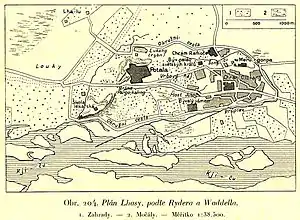
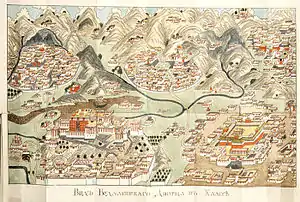
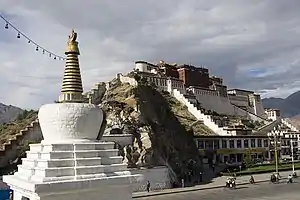
Appellations
L'appellation en tibétain de la porte ouest connaît plusieurs formes : outre Pargo Kaling, on rencontre Pawogaling (Peter Aufschnaiter[2]), Drakgo Kaling (André Alexander)[3], Barkokani ou Bakokani (G. Ts. Tsybikoff), et Bar chorten (G. Ts. Tsybikoff)[4].
Représentations
La représentation la plus ancienne connue figure sur la carte de Lhassa de Nikita Bitchourine (première moitié du XIXe siècle). Dans l'angle inférieur gauche, on aperçoit le grand chörten central avec son passage inférieur et les deux petits chörtens latéraux auxquels il est relié par des fils à clochettes.
Vient ensuite un dessin figurant sur la carte du Tibet central de la collection Wise, commanditée dans la deuxième moitié du XIXe siècle par le major britannique William Edmund Hay. Là aussi, le chörten central est relié par un fil orné de clochettes aux deux chörtens latéraux[5].
Dans son ouvrage Voyage à Lhassa et au Tibet central (1902), l'espion britannique et érudit indien Sarat Chandra Das décrit ainsi la porte ouest photographiée par l'explorateur bouriate G. Ts. Tsybikov en 1900-1901 : « Le grand bâtiment à deux étages à droite est une maison privée. Des fils, sur lesquels des clochettes sont suspendues, s'étendent de la cime du chörten au sommet des deux autres chörtens plus petits de part et d'autre du passage. »[6].
Histoire
C'est en passant sous le chörten que les soldats du corps expéditionnaire britannique au Tibet central entrent dans Lhassa le pour y défiler en grande tenue, précédés de l'escorte du commissaire impérial (garde du corps, piquiers et fantassins)[7]. Le colonel Francis Younghusband est accompagné de tous les membres de la mission, de correspondants de guerre, de deux compagnies de fusiliers royaux et de la 2e compagnie d'infanterie à cheval[8].
Dans les années 1980, la vieille porte ouest a disparu mais dans la décennie suivante le bâtiment est reconstruit à l'identique à son ancien emplacement par les autorités de Lhassa[9] - [10] - [11]. Selon l'architecte André Alexander, la date de la destruction est 1967 et celle de la reconstruction 1995[12].
Galerie
 Façade avant de la porte ouest en 1938.
Façade avant de la porte ouest en 1938. Façade arrière de la porte ouest en 1938.
Façade arrière de la porte ouest en 1938.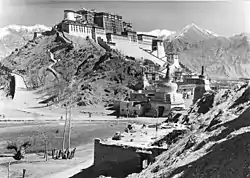 Porte ouest et palais du Potala en 1938.
Porte ouest et palais du Potala en 1938.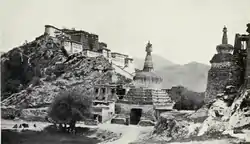 Porte ouest prise en 1904 par un photographe du corps expéditionnaire britannique.
Porte ouest prise en 1904 par un photographe du corps expéditionnaire britannique..jpg.webp) Le chörten central en 2015.
Le chörten central en 2015.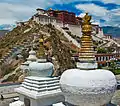 Les trois chörtens en 2009.
Les trois chörtens en 2009..jpg.webp) Le chörten central et le chörten au pied de la colline de Chagpori en 2011.
Le chörten central et le chörten au pied de la colline de Chagpori en 2011.
Notes et références
- (en) André Alexander, The Traditional Lhasa House: Typology of an Endangered Species, LIT Verlag Münster, 2013, 409 pages, p. 54 : « In 1948, [...] There were no more city walls, but two gates. One was the Drakgo-kaling, a gate consisting of three stupa monuments located between the Potamla Palace and Chakpori Hill (demolished in 1967 and rebuilt in 1995). »
- (en) Peter Aufschnaiter, Eight Years in Tibet, Bangkok, Orchid Press, 2002, p. 71.
- (en) André Alexander, The Traditional Lhasa House: Typology of an Endangered Species, LIT Verlag Münster, 2013, 409 pages, p. 54.
- (en) Lhasa, Bar Chorten, the Western Gate or Pargo Kaling gateway, Tibet - from the collection of the American Geographical Society Library, University of Wisconsin at Milwaukee.
- (en) Diana Lange, There’s More Than Meets the Eye with These Maps of Tibet, site de The Rubin, November 28, 2016 : « Lhasa’s former entrance gate (Pargo Kaling) and a group of people on the outer pilgrim circumambulation path (Lingkhor); detail of the Lhasa map (included in the panoramic map of Central Tibet) © The British Library Board, Add. Or. 3013, Folio 1 (detail). »
- Bibliothèque numérique mondiale, Lhassa, Bar Chorten, porte Pargo Kaling ou portail de l'occident, dernière mise à jour 22 mars 2016.
- (en) Edmund Candler, The Unveiling of Lhasa, London, Edward Arnold, 1905, p. 250 : « In front of us marched and rode the Amban's escort — his bodyguard, dressed in short loose coats of French gray, embroidered in black, with various emblems; pikemen clad in bright red with black embroidery and black pugarees; soldiers with pikes and scythes and three-pronged spears, on all of which hung red banners with devices embroidered in black. »
- Edmund Candler, op. cit., p. 250 : « An epoch in the world's history was marked to-day when Colonel Younghusband entered the city to return the visit of the Chinese Amban. He was accompanied by all the members of the mission, the war correspondents, and an escort of two companies of the Royal Fusiliers and the 2nd Mounted Infantry. »
- Clare Harris, The Museum of the Roof of the World: Art, Politics, and the Representation of Tibet, University of Chicago Press, 2012, 314 p., p. 199 : « The Lhasa authorities have made some attempt to reinstate it [the view] by rebuilding the three stupas of the Pargo Kaling (Western Gate) that was destroyed in the 1960s. »
- Lhasa map: 1980 : « In 1980, [...] The old city gate, in the form of a Buddhist stupa, has disappeared. »
- Lhasa Map: 1998 : « A replica of the old city gate has been built at the original site. »
- André Alexander, op. cit., p. 54 : « In 1948, [...] There were no more city walls, but two gates. One was the Drakgo-kaling, a gate consisting of three stupa monuments located between the Potala Palace and Chakpori Hill (demolished in 1967 and rebuilt in 1995). The other was located at the western edge of the central urban cluster, from where one had to cross a bridge and pass by the important Western Rigsum Gonpo temple in order to reach the Potala. »